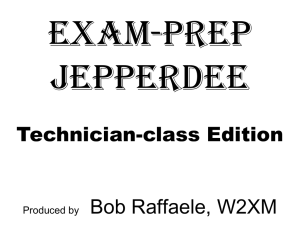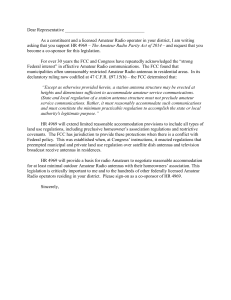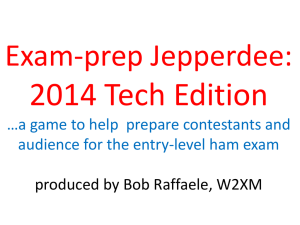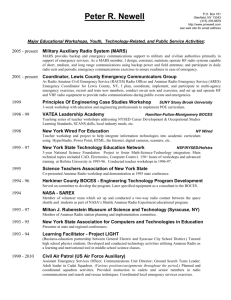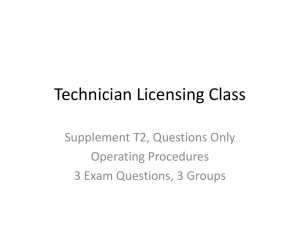Amateur Radio Technician Class Element 2 Course Presentation
advertisement
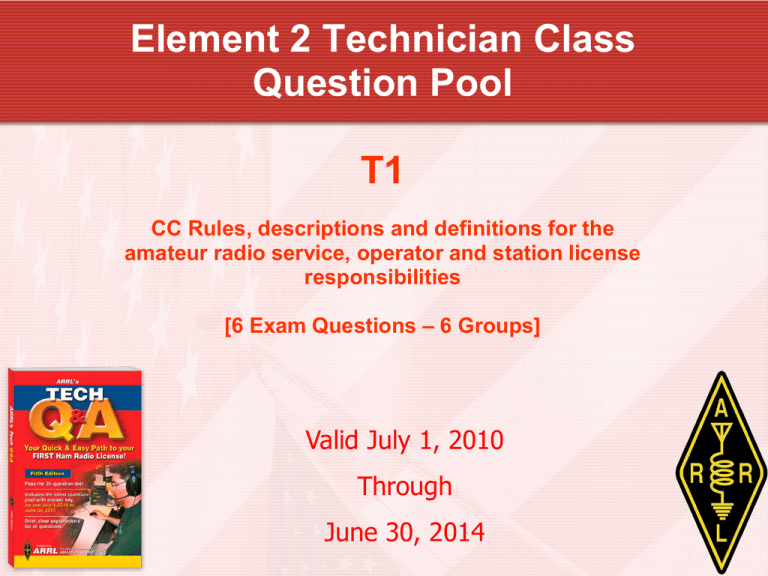
Element 2 Technician Class Question Pool T1 CC Rules, descriptions and definitions for the amateur radio service, operator and station license responsibilities [6 Exam Questions – 6 Groups] Valid July 1, 2010 Through June 30, 2014 T1A01 For whom is the Amateur Radio Service intended? A. Persons who have messages to broadcast to the public B. Persons who need communications for the activities of their immediate family members, relatives and friends C. Persons who need two-way communications for personal reasons D. Persons who are interested in radio technique solely with a personal aim and without pecuniary interest 2 T1A02 A. B. C. D. What agency regulates and enforces the rules for the Amateur Radio Service in the United States? FEMA The ITU The FCC Homeland Security 3 T1A03 A. B. C. D. Which part of the FCC rules contains the rules and regulations governing the Amateur Radio Service? Part 73 Part 95 Part 90 Part 97 4 T1A04 Which of the following meets the FCC definition of harmful interference? A. Radio transmissions that annoy users of a repeater B. Unwanted radio transmissions that cause costly harm to radio station apparatus C. That which seriously degrades, obstructs, or repeatedly interrupts a radio communication service operating in accordance with the Radio Regulations D. Static from lightning storms 5 T1A05 What is the FCC Part 97 definition of a space station? A. Any multi-stage satellite B. An Earth satellite that carries one of more amateur operators C. An amateur station located less than 25 km above the Earth's surface D. An amateur station located more than 50 km above the Earth's surface 6 T1A06 What is the FCC Part 97 definition of telecommand? A. An instruction bulletin issued by the FCC B. A one-way radio transmission of measurements at a distance from the measuring instrument C. A one-way transmission to initiate, modify or terminate functions of a device at a distance D. An instruction from a VEC 7 T1A07 What is the FCC Part 97 definition of telemetry? A. An information bulletin issued by the FCC B. A one-way transmission to initiate, modify or terminate functions of a device at a distance C. A one-way transmission of measurements at a distance from the measuring instrument D. An information bulletin from a VEC Congress of the United States 8 T1A08 A. B. C. D. Which of the following entities recommends transmit/receive channels and other parameters for auxiliary and repeater stations? Frequency Spectrum Manager Frequency Coordinator FCC Regional Field Office International Telecommunications Union 9 T1A09 Who selects a frequency coordinator? A. The FCC Office of Spectrum Management and Coordination Policy B. The local chapter of the Office of National Council of Independent Frequency Coordinators C. Amateur operators in a local or regional area whose stations are eligible to be auxiliary or repeater stations D. Regional field Office 10 T1A10 What is the FCC Part 97 definition of an amateur station? A. A station in an Amateur Radio Service consisting of the apparatus necessary for carrying on radio communications B. A building where Amateur Radio receivers, transmitters, and RF power amplifiers are installed C. Any radio station operated by a nonprofessional D. Any radio station for hobby use 11 T1A11 A. B. C. D. Which of the following stations transmits signals over the air from a remote receive site to a repeater for retransmission? Beacon station Relay station Auxiliary station Message forwarding station 12 T1B01 What is the ITU ? A. An agency of the United States Department of Telecommunications Management B. A United Nations agency for information and communication technology issues C. An independent frequency coordination agency D. A department of the FCC 13 T1B02 A. B. C. D. North American amateur stations are located in which ITU region? Region Region Region Region 1 2 3 4 14 T1B03 Which frequency is within the 6 meter band? A. B. C. D. 49.00 MHz 52.525 MHz 28.50 MHz 222.15 MHz 15 T1B04 A. B. C. D. Which amateur band are you using when your station is transmitting on 146.52 MHz? 2 meter band 20 meter band 14 meter band 6 meter band 16 T1B05 A. B. C. D. Which 70 cm frequency is authorized to a Technician Class license holder operating in ITU Region 2? 53.350 MHz 146.520 MHz 443.350 MHz 222.520 MHz 17 T1B06 A. B. C. D. Which 23 cm frequency is authorized to a Technician Class operator license? 2315 MHz 1296 MHz 3390 MHz 146.52 MHz 18 T1B07 A. B. C. D. What amateur band are you using if you are transmitting on 223.50 MHz? 15 meter band 10 meter band 2 meter band 1.25 meter band 19 T1B08 What do the FCC rules mean when an amateur frequency band is said to be available on a secondary basis? A. Secondary users of a frequency have equal rights to operate B. Amateurs are only allowed to use the frequency at night C. Amateurs may not cause harmful interference to primary users D. Secondary users are not allowed on amateur bands 20 T1B09 Why should you not set your transmit frequency to be exactly at the edge of an amateur band or sub-band? A. To allow for calibration error in the transmitter frequency display B. So that modulation sidebands do not extend beyond the band edge C. To allow for transmitter frequency drift D. All of these choices are correct 21 T1B10 A. B. C. D. Which of the bands available to Technician Class operators have moderestricted sub-bands? The 6 meter, 2 meter, and 70 cm bands The 2 meter and 13 cm bands The 6 meter, 2 meter, and 1.25 meter bands The 2 meter and 70 cm bands 22 T1B11 A. B. C. D. What emission modes are permitted in the mode-restricted sub-bands at 50.0 to 50.1 MHz and 144.0 to 144.1 MHz? CW only CW and RTTY SSB only CW and SSB 23 T1C01 Which type of call sign has a single letter in both the prefix and suffix? A. B. C. D. Vanity Sequential Special event In-memoriam 24 T1C02 A. B. C. D. Which of the following is a valid US amateur radio station call sign? KMA3503 W3ABC KDKA 11Q1176 25 T1C03 What types of international communications are permitted by an FCC-licensed amateur station? A. Communications incidental to the purposes of the amateur service and remarks of a personal character B. Communications incidental to conducting business or remarks of a personal nature C. Only communications incidental to contest exchanges, all other communications are prohibited D. Any communications that would be permitted on an international broadcast station 26 T1C04 When are you allowed to operate your amateur station in a foreign country? A. When the foreign country authorizes it B. When there is a mutual agreement allowing third party communications C. When authorization permits amateur communications in a foreign language D. When you are communicating with nonlicensed individuals in another country 27 T1C05 What must you do if you are operating on the 23 cm band and learn that you are interfering with a radiolocation station outside the US? A. Stop operating or take steps to eliminate the harmful interference B. Nothing, because this band is allocated exclusively to the amateur service C. Establish contact with the radiolocation station and ask them to change frequency D. Change to CW mode, because this would not likely cause interference 28 T1C06 From which of the following may an FCC-licensed amateur station transmit, in addition to places where the FCC regulates communications? A. From within any country that belongs to the International Telecommunications Union B. From within any country that is a member of the United Nations C. From anywhere within in ITU Regions 2 and 3 D. From any vessel or craft located in international waters and documented or registered in the United States 29 T1C07 What may result when correspondence from the FCC is returned as undeliverable because the grantee failed to provide the correct mailing address? A. Fine or imprisonment B. Revocation of the station license or suspension of the operator license C. Require the licensee to be re-examined D. A reduction of one rank in operator class 30 T1C08 A. B. C. D. What is the normal term for an FCC-issued primary station/operator license grant? Five years Life Ten years Twenty years 31 T1C09 A. B. C. D. What is the grace period following the expiration of an amateur license within which the license may be renewed? Two years Three years Five years Ten years 32 T1C10 How soon may you operate a transmitter on an amateur service frequency after you pass the examination required for your first amateur radio license? A. Immediately B. 30 days after the test date C. As soon as your name and call sign appear in the FCC’s ULS database D. You must wait until you receive your license in the mail from the FCC. 33 T1C11 If your license has expired and is still within the allowable grace period, may you continue to operate a transmitter on amateur radio frequencies? A. No, transmitting is not allowed until the ULS database shows that the license has been renewed B. Yes, but only if you identify using the suffix "GP" C. Yes, but only during authorized nets D. Yes, for up to two years 34 T1D01 With which countries are FCC-licensed amateur stations prohibited from exchanging communications? A. Any country whose administration has notified the ITU that it objects to such communications B. B. Any country whose administration has notified the United Nations that it objects to such communications C. C. Any country engaged in hostilities with another country D. D. Any country in violation of the War Powers Act of 1934 35 T1D02 On which of the following occasions may an FCC-licensed amateur station exchange messages with a U.S. military station? A. During an Armed Forces Day Communications Test B. During a Memorial Day Celebration C. During an Independence Day celebration D. During a propagation test 36 T1D03 When is the transmission of codes or ciphers allowed to hide the meaning of a message transmitted by an amateur station? A. Only during contests B. Only when operating mobile C. Only when transmitting control commands to space stations or radio control craft D. Only when frequencies above 1280 MHz are used 37 T1D04 What is the only time an amateur station is authorized to transmit music? A. When incidental to an authorized retransmission of manned spacecraft communications B. B. When the music produces no spurious emissions C. C. When the purpose is to interfere with an illegal transmission D. D. When the music is transmitted above 1280 MHz 38 T1D05 When may amateur radio operators use their stations to notify other amateurs of the availability of equipment for sale or trade? A. When the equipment is normally used in an amateur station and such activity is not conducted on a regular basis B. B. When the asking price is $100.00 or less C. C. When the asking price is less than its appraised value D. D. When the equipment is not the personal property of either the station licensee or the control operator or their close relatives 39 T1D06 Which of the following types of transmissions are prohibited? A. Transmissions that contain obscene or indecent words or language B. B. Transmissions to establish one-way communications C. C. Transmissions to establish model aircraft control D. D. Transmissions for third party communications 40 T1D07 When is an amateur station authorized to automatically retransmit the radio signals of other amateur stations? A. When the signals are from an auxiliary, beacon, or Earth station B. When the signals are from an auxiliary, repeater, or space station C. When the signals are from a beacon, repeater, or space station D. When the signals are from an Earth, repeater, or space station 41 T1D08 When may the control operator of an amateur station receive compensation for operating the station? A. When engaging in communications on behalf of their employer B. When the communication is incidental to classroom instruction at an educational institution C. When re-broadcasting weather alerts during a RACES net D. When notifying other amateur operators of the availability for sale or trade of apparatus 42 T1D09 Under which of the following circumstances are amateur stations authorized to transmit signals related to broadcasting, program production, or news gathering, assuming no other means is available? A. Only where such communications directly relate to the immediate safety of human life or protection of property B. Only when broadcasting communications to or from the space shuttle. C. Only where noncommercial programming is gathered and supplied exclusively to the National Public Radio network D. Only when using amateur repeaters linked to the Internet 43 T1D10 What is the meaning of the term broadcasting in the FCC rules for the amateur services? A. Two-way transmissions by amateur stations B. Transmission of music C. Transmission of messages directed only to amateur operators D. Transmissions intended for reception by the general public 44 T1D11 Which of the following types of communications are permitted in the Amateur Radio Service? A. Brief transmissions to make station adjustments B. Retransmission of entertainment programming from a commercial radio or TV station C. Retransmission of entertainment material from a public radio or TV station D. Communications on a regular basis that could reasonably be furnished alternatively through other radio services 45 T1E01 When must an amateur station have a control operator? A. Only when the station is transmitting B. Only when the station is being locally controlled C. Only when the station is being remotely controlled D. Only when the station is being automatically controlled 46 T1E02 Who is eligible to be the control operator of an amateur station? A. Only a person holding an amateur service license from any country that belongs to the United Nations B. Only a citizen of the United States C. Only a person over the age of 18 D. Only a person for whom an amateur operator/primary station license grant appears in the FCC database or who is authorized for alien reciprocal operation 47 T1E03 A. B. C. D. Who must designate the station control operator? The station licensee The FCC The frequency coordinator The ITU 48 T1E04 What determines the transmitting privileges of an amateur station? A. The frequency authorized by the frequency coordinator B. The class of operator license held by the station licensee C. The highest class of operator license held by anyone on the premises D. The class of operator license held by the control operator 49 T1E05 What is an amateur station control point? A. The location of the station’s transmitting antenna B. The location of the station transmitting apparatus. C. The location at which the control operator function is performed D. The mailing address of the station licensee 50 T1E06 A. B. C. D. Under which of the following types of control is it permissible for the control operator to be at a location other than the control point? Local control Automatic control Remote control Indirect control 51 T1E07 When the control operator is not the station licensee, who is responsible for the proper operation of the station? A. All licensed amateurs who are present at the operation B. Only the station licensee C. Only the control operator D. The control operator and the station licensee are equally responsible 52 T1E08 A. B. C. D. What type of control is being used for a repeater when the control operator is not present at a control point? Local control Remote control Automatic control Unattended 53 T1E09 A. B. C. D. What type of control is being used when transmitting using a handheld radio? Radio control Unattended control Automatic control Local control 54 T1E10 A. B. C. D. What type of control is used when the control operator is not at the station location but can indirectly manipulate the operating adjustments of a station? Local Remote Automatic Unattended 55 T1E11 A. B. C. D. Who does the FCC presume to be the control operator of an amateur station, unless documentation to the contrary is in the station records? The station custodian The third party participant The person operating the station equipment The station licensee 56 T1F01 A. B. C. D. What type of identification is being used when identifying a station on the air as “Race Headquarters”? Tactical call Self-assigned designator SSID Broadcast station 57 T1F02 A. B. C. D. When using tactical identifiers, how often must your station transmit the station’s FCC-assigned call sign? Never, the tactical call is sufficient Once during every hour Every ten minutes At the end of every communication 58 T1F03 When is an amateur station required to transmit its assigned call sign? A. At the beginning of each contact, and every 10 minutes thereafter B. At least once during each transmission C. At least every 15 minutes during and at the end of a contact D. At least every 10 minutes during and at the end of a contact 59 T1F04 Which of the following is an acceptable method of station identification when operating in the phone sub-band? A. Any language recognized by the United Nations B. Any language recognized by the ITU C. The English language D. English, French, or Spanish 60 T1F05 A. B. C. D. What method of call sign identification is required for a station transmitting phone signals? Send the call sign followed by the indicator RPT Send the call sign using CW or phone emission Send the call sign followed by the indicator R Send the call sign using only phone emission 61 T1F06 A. B. C. D. Which of the following formats of a selfassigned indicator is acceptable when identifying using a phone transmission? KL7CC stroke W3 KL7CC slant W3 KL7CC slash W3 All of these choices are correct 62 T1F07 Which of the following restrictions apply when appending a self-assigned call sign indicator? A. It must be more than three letters and less than five letters B. It must be less than five letters C. It must start with the letters AA through AL, K, N, or W and be not less than two characters or more than five characters in length D. It must not conflict with any other indicator specified by the FCC rules or with any call sign prefix assigned to another country 63 T1F08 A. B. C. D. When may a Technician Class licensee be the control operator of a station operating in an exclusive Extra Class operator segment of the amateur bands? Never On Armed Forces Day As part of a multi-operator contest team When using a club station whose trustee is an Extra Class operator licensee 64 T1F09 A. B. C. D. What type of amateur station simultaneously retransmits the signal of another amateur station on a different channel or channels? Beacon station Earth station Repeater station Message forwarding station 65 T1F10 A. B. C. D. Who is accountable should a repeater inadvertently retransmit communications that violate the FCC rules? The control operator of the originating station The control operator of the repeater The owner of the repeater Both the originating station and the repeater owner 66 T1F11 To which foreign stations do the FCC rules authorize the transmission of non-emergency third party communications? A. Any station whose government permits such communications B. Those in ITU Region 2 only C. Those in ITU Regions 2 and 3 only D. Those in ITU Region 3 only 67 T1F12 A. B. C. D. How many persons are required to be members of a club for a club station license to be issued by the FCC? At least 5 At least 4 A trustee and 2 officers At least 2 68 T1F13 A. B. C. D. When must the station licensee make the station and its records available for FCC inspection? Any time upon request by an official observer Any time upon request by an FCC representative 30 days prior to renewal of the station license 10 days before the first transmission 69
